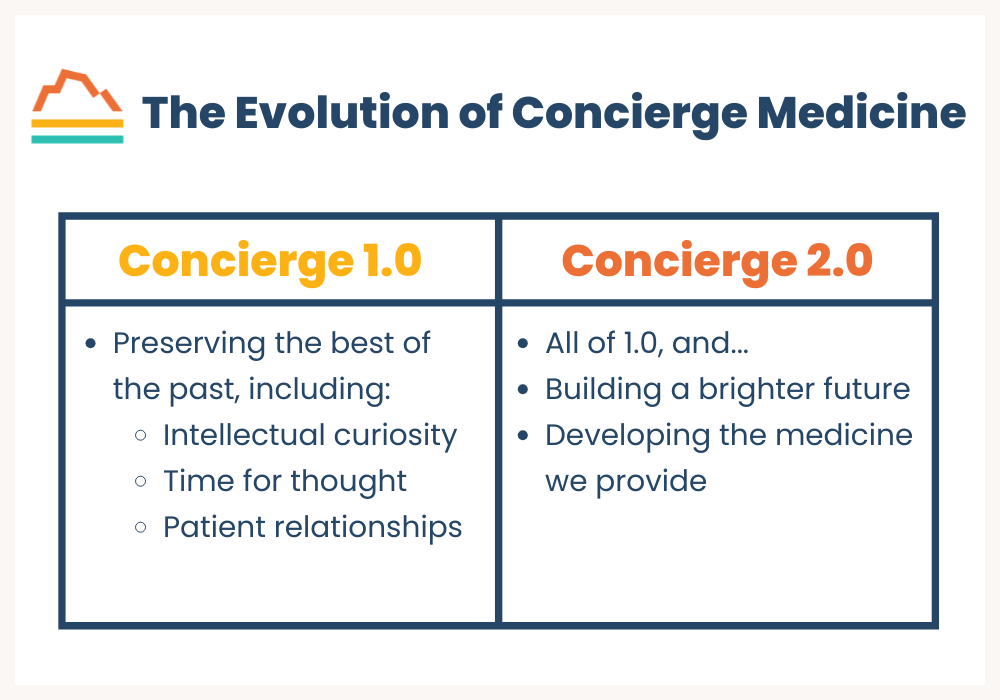In July of 2007, I proudly became the second concierge medical doctor in Contra Costa County, California, pioneering a new way to bring high-quality care to patients. At the time, patients valued concierge medicine for its same-day care and after-hours phone calls.
My practice grew, and my patients were happy. For a while, running a successful practice was enough to satisfy me.
Over the past 18 years, I’ve watched the concierge medicine model evolve to become more widespread and accepted. At Banner Peak Health, I’ve helped drive that evolution toward what I call concierge medicine 2.0.
Concierge Medicine 1.0
Concierge medicine 1.0 is high-quality medical care that prioritizes patients and is not beholden to insurance companies. It preserves the golden era of medicine by prioritizing the patient-doctor relationship and upholding medicine’s core values:
- Patient rights
- Intellectual inquiry
- Patient-doctor bonding
- Differential diagnosis
Concierge medicine 2.0 moves beyond merely preserving the best traditions of medicine and develops new techniques to move healthcare forward.
Concierge Medicine 2.0
The concierge medicine model is appreciably different from fee-for-service healthcare. While 1.0 is high-quality internal medicine, 2.0 involves access to new technology and techniques unavailable in any other system.
At Banner Peak Health, we have access to diagnostic modalities not covered by insurance and labor-intensive treatment opportunities, which many traditional fee-for-service physicians can’t offer.
These treatments include:
- Galleri cancer screening, a simple blood test that can detect 50+ types of cancer.
- Coronary artery calcium score, a more accurate means of detecting heart disease risk than cholesterol alone.
- InBody scan, a complete body composition scan more accurate than BMI.
- SleepImage device, a comprehensive sleep study done at home with simple, precise technology.
- Labor-intensive testing techniques, which traditional healthcare lacks the bandwidth to offer. These include continuous glucose monitoring, the Oura Ring, and heart rate variability (HRV) measurement.
These advancements allow Banner Peak Health to provide personalized, direct, state-of-the-art care.
Looking Ahead
In recent years, we’ve seen an explosion in both FDA-approved and non-FDA-approved medical technology. My challenge and privilege is guiding my patients through the labyrinth of options.
The concierge medicine 1.0 model still struggles with bandwidth, though not as much as traditional healthcare. However, concierge medicine 2.0 facilities like Banner Peak Health are able and determined to better meet members’ needs.
As we move into the latter half of the 2020s, expect an increase in the prevalence of consumer wearables, like the Oura Ring. We expect manufacturers to develop and distribute these outside the medical industry, but we’ll break down silos and continue to identify and validate medical applications.
For example, sports medicine pioneered techniques for measuring and monitoring heart rate variability, but we now understand its relevance in internal medicine.
Today’s Takeaways
Concierge medicine 1.0 is superior to conventional (insurance-based) healthcare. However, at Banner Peak Health, we always want to push forward. We’re proud to offer concierge medicine 2.0, and we’ll continue to expand our practice.


Barry Rotman, MD
For over 30 years in medicine, Dr. Rotman has dedicated himself to excellence. With patients’ health as his top priority, he opened his own concierge medical practice in 2007 to practice medicine in a way that lets him truly serve their best interests.




